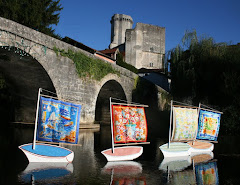It’s no wonder that the galloping fire quickly devoured everything in its path. Behind the watchful gaze of gargoyles and chimeras, and under the lace-like stonework of Notre-Dame there was an enormous expanse of attic. An attic filled with timbers dating from the cathedral’s construction in the 12th and 13th centuries. There were so many “trees” up there that the space was nick named The Forest. Way back when, workers cleared 21 hectares (52 acres) of oak trees from the countryside surrounding the city of Paris. Carpenters used the massive trees to achieve the dramatic heights required for the soaring Gothic style. Trees that had sprouted in the 8th or 9th centuries. Trees that were between 300 to 400 years old when cut down. In order to get the dimensions and structure right in the Middle Ages workers first built the frame on the ground then, it would be disassembled and hoisted to the ceiling with lifting gear where it was reassembled. Gothic style required that the oak beams be set at 55-degree angles. Back then, churches tended to use clay tiles, but in Paris, being far from clay deposits, this roof was lead and weighed 210 tons.
It was two years ago in 2019 that I stood there for hours watching Notre Dame burn. At first a French cultural heritage expert said that the cathedral’s roof could not be rebuilt as it had been. Modern materials had to be used for efficiency and safety. He stated, “The biggest obstacle is we don’t, at the moment, have trees on our territory of the size that were cut in the 13th century. France no longer has trees big enough to replace those ancient wooden beams.” He spoke too soon. He underestimated the resources, the generosity, and the pride of heritage of his fellow Frenchies.
“Given the place occupied by the cathedral in the hearts of the French, in the history of France, and the world ... we are happy (that) the entire industry — from foresters to sawyers — is mobilized to meet this challenge,” said Michel Druilhe, President of France Bois Foret, a national inter-professional forestry network.
Each beam in The Forest is constructed from a single tree. 13,000 trees will be needed. Many forests will be at play in this epic reconstruction. A call went out to a web of foresters spread all over France to start the daunting and time sensitive search.
Here’s the criteria they use for a “perfect” tree:
- the most important characteristic is the straightness of the tree- it’s rectitude
- they have to be long and straight, but once cut it might be discovered that the wood is slightly twisted - one has to examine the uncut tree from all angles and with expertise and experience
- it’s internal fibers have to be correct/straight otherwise it might twist during drying or milling
- there can be no low branches (living branches higher up are ok)
- no knots
- a diameter of more than 50 centimeters
- no beetles that have eaten up the insides or are a nursery to the beetles
Now here’s where southwestern France comes in—
Even before the enormous task of finding enough trees to rebuild The Forest got started forestry expert Jacques Hazera had spotted some impressive ancient trees in his territory. In total he knows of 15 or so trees in the Aquitaine region that meet the criteria for being usable in this noble project. Only five will be cut down.
Three of these trees were inventoried in a private forest. The oaks on Madame de Villeneuve’s property met all of the requirements to a T. Each one has a circumference between 1.65 and 1.8 meters (64 to 70 inches). And 8 to 12 meters (26 to 40 feet) of perfectly straight lumber. Her only disappointment is that her oaks, venerable though they my be, don’t attain the 18 meters high qualification to to be used for the spire. The spire will require 80 oaks that are at least 200 years old.
On the 12th of March 2021 standing in her family’s private forest Madame Francoise de Villeneuve wasn’t hiding her joy. Three of her oak trees had been selected for the reconstruction of Notre-Dame-de-Paris. “When they asked me if I would be interested in contributing the trees I said yes right away. I am a faithful Catholic and a woodland manager. This is a great honor for my family and a tribute to the previous generations that planted these trees at the beginning of the twentieth century.” The trees were originally planted for barrel making or use for the French Navy. These giants are now a gift from her family and their forest to Notre Dame, France, and the world. Madame Francoise de Villeneuve is paying for cutting the tree down, having it transported, and the cost of conditioning the wood.
That afternoon chainsaw-wielding tree surgeons scaled the qualifying oaks to fell them in a race against the clock. Throughout France the selected trees have to be “harvested” by the end of March, otherwise harmful tree sap and moisture could enter the wood fibers. Once cut the trees stay in place until the forest floor hardens up after a wet winter. Horses will be used to drag the trees to the road side - around the month of May. The enormous logs are then trucked to the lumberyard for seasoning, treatment for preservation, and conversion to lumber. Eventually each piece of wood will be tagged with an identity plaque indicating its forest of origin and placement in the attic of the cathedral. The proud owners will know where their tree is located in the New Forest of Notre Dame.
There is one more important requirement in the tree to lumber process - patience. The trunks must be left to dry for up to 18 months. Not good news to the French President who promised to have Notre Dame Cathedral ready for visitors by the 2024 Paris Olympics. Time will tell.
There are those that fear that cutting these old trees is harmful or bringing an end to an era, but all of these venerable trees were deliberately planted to be used in production some day. That time has come. Here is a big thank you to all the generous landowners. Here’s a heartfelt homage to the ancient trees.
Now it’s time to plant some more tiny saplings for future grand projects.
information collected from Sud-Ouest and various other journals
images borrowed from google images
--thank you for letting me share and inform



















3 comments:
Fascinating post. Thanks for the update information. I really enjoyed reading about Madame de Villeneuve's contribution.
Great article? Loved the explanation of the criteria and process. Wish I had a tree to contribute.
I love this. Love it. I remember watching every minute I saw of this -- even when we had a meeting at a local restaurant, the TV was on and people just stopped and stood by it, shaking their heads in horror and sadness. What a gift this woman has made and one that will live on for generations to come.
Post a Comment